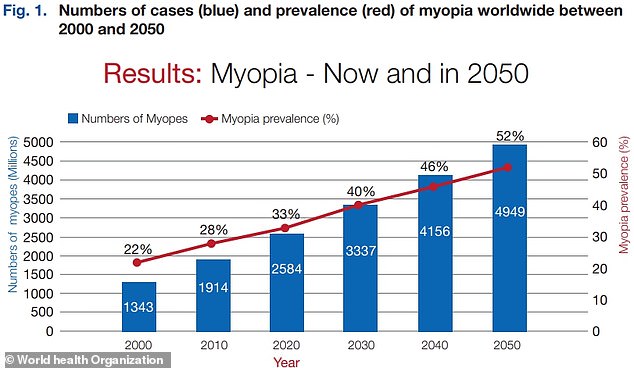The pandemic may be responsible for the skyrocketing levels of myopia in children, researchers revealed today.
Experts have long warned that this is because young people are spending less time outdoors and more time watching television and playing video games.
But scientists said COVID, which forced millions of people to stay at home, may have “accelerated vision decline” in children.
According to a landmark global analysis, one in three children is now nearsighted, or unable to see things clearly in the distance.
Globally, rates of myopia (the medical name for nearsightedness) tripled between 1990 and 2023, reaching 36 percent.
Experts have long warned that this is because young people are spending less time outdoors and more time watching television and playing video games.

The World Health Organization estimates that more than half of the world’s population will suffer from myopia by 2050, compared with a third today, due to increased time spent indoors and doing “near work,” such as spending more time on schoolwork.
Writing in the British Journal of OphthalmologyChinese experts warned: “Emerging evidence suggests a potential association between the pandemic and accelerated vision decline among young adults.”
Myopia occurs when the eyes grow slightly too long, causing light to focus just in front of the retina instead of on it, meaning distant objects appear blurry.
The condition often runs in families and has been linked to focusing on nearby objects, such as books and computers, for long periods in childhood.
It is believed that around 20 million Britons and 137 million Americans suffer from it.
The World Health Organization estimates that more than half of the world’s population will suffer from myopia by 2050 due to increased time spent indoors and doing “near work” such as schoolwork.
But a previous global review on the prevalence of the disease only included studies up to 2015.
To paint a more accurate picture, researchers at Sun Yat-sen University in Guangzhou, China, analyzed 276 studies involving more than five million children in 50 countries.
Geographic variables were taken into account, they said.
The highest rates were found in East Asia, with 86 percent of children in Japan and 74 percent in South Korea diagnosed with myopia.
Russia ranks third with more than 40 percent of those affected.
In comparison, Paraguay and Uganda recorded some of the lowest levels, around one percent.
The United Kingdom and the United States were at around 15 percent.
According to the new research, the number of cases of myopia among children and adolescents will also exceed 740 million cases by 2050.
The researchers also suggested that girls are likely to have higher rates than boys because they tend to spend less time doing outdoor activities at school and staying at home as they get older.
“Despite these known limitations, given the large sample size included, our estimates of myopia prevalence are considered to be close to accurate,” they added.
Signs of this condition include sitting close to the TV, complaining of headaches or tired eyes, and regularly rubbing your eyes.
UK vision experts have long advised that children should spend at least two hours outdoors each day, especially between the ages of seven and nine, to reduce the risk of developing short-sightedness.
It is not clear whether it is the presence of natural sunlight, outdoor exercise or the fact that children’s eyes focus on more distant objects that makes the difference.
“There is a real benefit to children being outdoors,” said Daniel Hardiman-McCartney, clinical adviser to the College of Optometrists in the UK.
Myopia cannot be cured but can be corrected with glasses or contact lenses.
Special lenses can slow the development of nearsightedness in young children by stimulating eye growth differently, but they are expensive.


